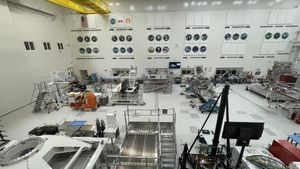On November 15, 2024, Jerome Powell, Chair of the Federal Reserve, addressed the pressing issue of interest rates during his remarks at a financial gathering in Dallas, Texas. With inflation remaining at the forefront of economic discussions, Powell indicated the central bank's cautious approach to rate cuts. "The economy is strong, and we're watching inflation closely," he stated, alluding to the Fed's objective to maintain economic stability.
The Fed’s last two meetings have resulted in interest rate cuts, including a quarter-point reduction just last week. While many economists predict another such cut to come soon, Powell emphasized the importance of deliberation moving forward. "We need to monitor how inflation behaves before proceeding with any more significant cuts," he explained. Recent figures suggest inflation is edging closer to the Fed's coveted 2% target, yet Powell stressed it is still not there. This balance, he articulated, is pivotal for developing the right monetary policy.
An intriguing aspect of Powell's remarks included how expectations for inflation affect public perception and behavior. He reinforced the Fed's independence from political influence, particularly alluding to former President Donald Trump's previous threats to remove him from his position for not enacting swift rate cuts. Powell’s belief is rooted deeply in the idea of maintaining public faith, stating, "The public believed we would get inflation down, and that's what's necessary for price stability."
Analysts have been speculating following Powell's comment, with futures contracts now showing lowered expectations for future rate cuts—particularly one scheduled for December, now predicted at just below 59%. This marks a significant shift from earlier projections which were substantially higher, reflecting the uncertainty surrounding inflation forecasts and economic conditions.
Core inflation, which strips out volatile categories such as food and energy, has remained stubbornly high, hovering around the 2% rate for five months. This stagnation has put the Fed's policymakers at odds, with many remaining skeptical about how much they can cut rates without igniting inflation again. Lorie Logan, the president of the Dallas Fed, articulated her view, noting the importance of caution: "If we cut too far, inflation could reaccelerate, causing the Fed to reverse those cuts. We need to be careful here."
Despite these concerns, Powell conveyed optimism about the economy's robustness, citing strong growth indicators and low unemployment rates. He pointed out the necessity to approach all decisions carefully, ensuring the domestic economy does not suffer from rash measures. According to Powell, the pathway forward will be marked by continued attention to consumer behavior, market reactions, and broader economic signals.
It's also important to recognize the role of external factors impacting inflation. Recent tax reductions and anticipated fiscal policies under Trump's possible second term paint complex scenarios for the Fed. The potential implementation of widespread tariffs could lead to increased consumer prices, creating more uncertainty for the economy and the Fed’s monetary policy directives.
Powell's commitment to transparency and clarity seems to resonate well with various stakeholders, pointing to the Fed’s efforts to communicate openly about its challenges and decisions. Observers across the financial sector are closely monitoring these developments, with all eyes on the next Federal Open Market Committee meeting scheduled for December.
Overall, Powell’s remarks encapsulate the tricky balancing act the Fed is attempting to maintain: nurturing economic growth without letting inflation spiral. The upcoming months will certainly test the resilience of this approach, as the nation grapples with inflation and its accompanying risks.



